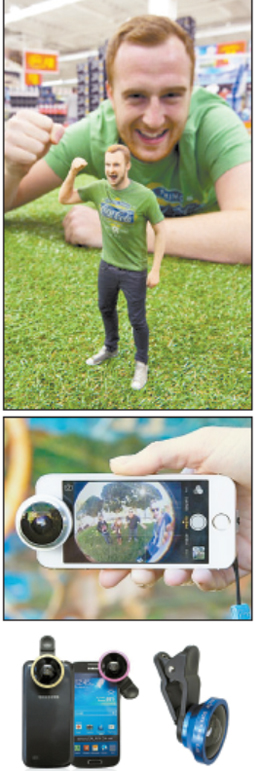Technology offers choices for you and your selfies

Top: U.K. supermarket chain ASDA provides a 3-D printing service where consumers can get 3-D replica of themselves. Above: Portable selfie lenses allows for wide-angle shooting, attached to smartphones.Provided by ASDA, Photojojo
Now, some selfie-lovers are looking for something more than a two-dimensional image: a 3-D version of their face and body.
Their dream can be realized if they turn to 3-D printers.
The process typically uses a full-body scanner that records all of the necessary details as a customer steps in and strikes a pose.
The scanning process usually takes only a minute.
The images are then processed by a computer, to create a digital 3-D on-screen image, after which the image is sent to a 3-D printer that transforms it into a figure.
Though it is still hard to call it a mainstream trend, several retailers and 3-D printing companies have seized on the growing interest in 3-D selfies.
Among them is U.K. supermarket chain ASDA, which offers a 3-D printing service, called 3DME, for 60 pounds ($94).
It takes 12 seconds to scan a full body and another 8 hours to make a figurine 18 centimeters (7.1 inches) high.
For 62-year-old Thomas Tucker, who purchased a replica of himself from ASDA, the figure serves as motivation to stay healthy and in shape.
Tucker, who lives in Edinburgh, was diagnosed as obese before he shed weight through diet and exercise.
What he did next was go to the supermarket chain and purchase a model of himself to commemorate his accomplishment.
“I thought I’d get one of them and look at it now and again to remind myself of how I should be,” Tucker said. “I feel as though I’ve prolonged my life.”
Artec Group, a Luxembourg-based 3-D scanner company, targets the U.S. market, launching its Shapify Booths in Freehold, New Jersey, and Portland, Oregon, in April.
The company hopes the machine will preserve memories in the same way as cameras.
“As a kid, you may have gotten into a photo booth with your friends and had a strip of pictures printed out to commemorate the occasion,” said Artyom Yukhin, CEO of Artec Group. “Our goal is to have this generation do the same thing, but add another dimension and in the end have a 3-D printed figurine to solidify the memory.”
Selfies used to be considered a simple craze, but some observers see the trend becoming so ubiquitous that it can impact the tech industry.
“The selfie is a new segment of culture that arrived with the advent of social networking sites,” said Ryu Cheol-gyoon, a professor of digital media at Ewha Womans University. “The culture tapped into narcissism and people’s desire to share.
“So far, digital cameras and the spread of the Internet contributed to the popularity of the selfie. But it now prompts tech companies to leverage their technologies so that they can generate a better, fresher type of selfie.”
Three-dimensional printing is not the only technology that is taking advantage of the selfie trend.
Here comes another much-discussed device: the drone.
Nixie is a drone that can take pictures as it is thrown into the air.
Users can remotely launch it, and then Nixie flies toward users.
During its flight, the drone takes a selfie automatically.
If drones and 3-D printing sound too fancy, one can opt for small lenses and accessories to attain selfie diversity.
Portable lenses deliver several options for selfie-lovers.
Often called a “selfie lens,” the detachable lens fits on mobile phones.
Since it has a built-in clip, the lenses can be attached to the smartphone camera both on the front and rear.
The products allow for wider perspectives by expanding viewing angles to between 130 and 140 degrees.
Selfie lenses are often bundled with fish-eye lenses.
Editing applications for selfies and self-video shooting also are in demand as people want to have their images beautified.
Lollicam allows users to edit video footage simultaneously while shooting a video.
“Hundreds of millions of people now have smartphones, and they are eager to communicate through photos and videos,” said Jeong Jin-wook, CEO of Seerslab, which developed the Lollicam.
“So as people now want a fresh type of selfie, the selfie culture will continue to change.”
BY PARK EUN-JEE [park.eunjee@joongang.co.kr]










with the Korea JoongAng Daily
To write comments, please log in to one of the accounts.
Standards Board Policy (0/250자)